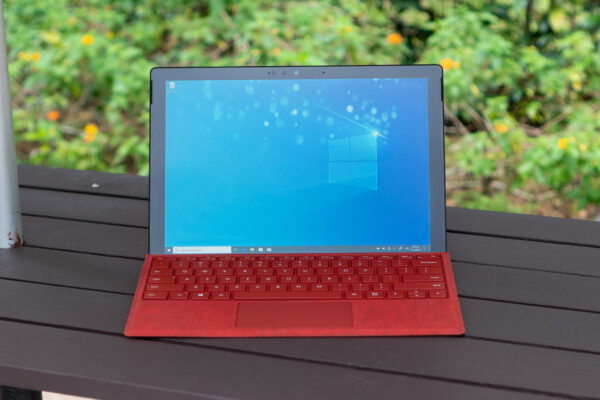
Microsoft launched the 7th generation of their Surface Pro tablet last October. The incremental improvements the Surface Pro 7 brings to the table are welcomed. Though there isn’t any major leap forward, it may be just good enough for most casual tablet users.
The first Surface tablet launched way back in 2012 was an ARM-based device that wasn’t quite the Windows tablet that most people wanted. Microsoft fixed that with the first Surface Pro running an Intel processor in early 2013. Since then, we’ve seen several cycles of updates, and while they are all excellent tablets, there has always been something that prevented me from enthusiastically recommending them. The Surface Pro 7 may just change that.
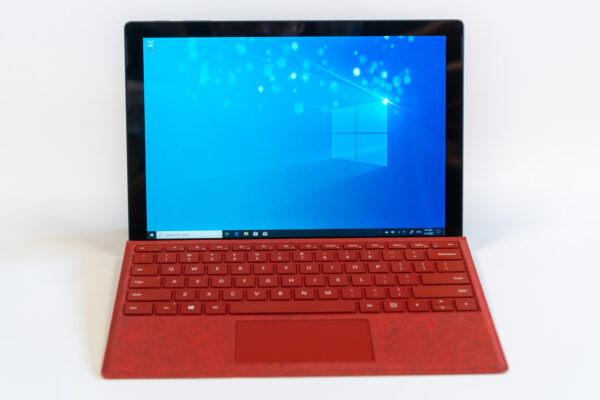
The Surface Pro line comprises 2-in-1 keyboard-detachable convertible devices. The keyboard, called the Type Cover and is sold separately, attaches magnetically. The new Surface Pro 7 is unchanged.
In fact, there are more things unchanged in the Surface Pro 7 from the previous Surface Pro 6 than there are differences. To start with, the actual tablet is pretty much the same size and looks the same. It’s easy to carry around, since it measures only 292 x 201 x 8.5 mm and weighs 790 grams.
The display is the same 12.3-inch PixelSense with 2736×1824 pixel resolution. This is a 3:2 aspect ratio screen, much taller than what you might be accustomed to on other notebooks whirech typically offer 16:9 aspect ratio. The taller screen makes it easier to work with documents and browser pages. It is also much more practical when you want to use the Surface Pro 7 as a tablet.
In testing with Spyder5PRO, the PixelSense display achieved 93%, 64% and 69% sRGB, NTSC, and AdobeRGB colour gamut coverage respectively. At maximum brightness, the screen can get to 417 nits, which is pretty bright, and good enough to work comfortably outdoors. At the same time, the screen can dim all the way down, with full white colour at minimum brightness putting out 2.9 nits, so the screen will work very comfortably in a dark room.
The bezels around the display are the same as before. They probably count as very thick by most expectations these days. There’s a Windows Hello 5.0 MP camera with 1080p video support above the screen. The second camera, on the back of the tablet, has a 8.0 MP sensor, also with 1080p video support.
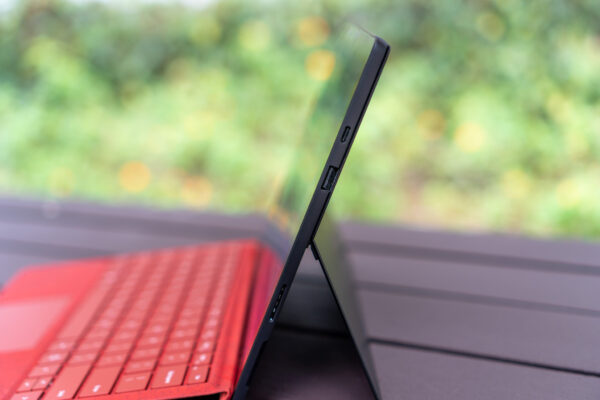
For ports, you get a Surface Connect port, a USB 3.1 Type-A port, and a USB 3.1 Type-C port. That last port is perhaps one of the most interesting upgrade in the Surface Pro 7, replacing the Mini-DisplayPort from the Surface Pro 6.
The USB Type-C port does not, unfortunately, support Thunderbolt. It does support an external display, as well as work with USB Type-C dongles and docks. Most importantly, it supports USB Power Delivery, so you can charge the Surface Pro 7 with 3rd party chargers, provided it can put out enough power. Officially, Microsoft says you should use something that matches the provided power supply, which means 65 Watts in this case. I had no problems using a 45 Watt USB PD charger.
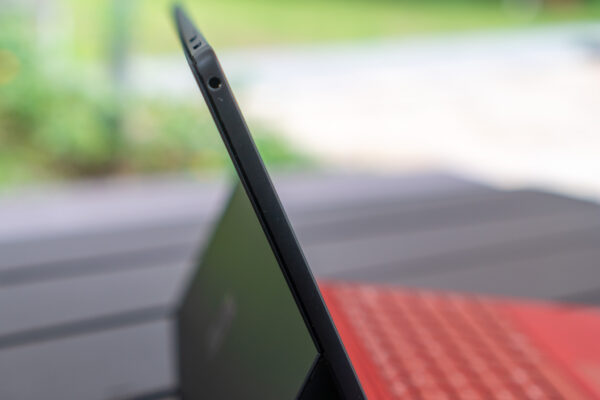
There’s a 3.5 mm audio jack on the other side of the tablet, and a microSD slot on the back.
I find it very useful to have physical volume buttons. These are found on the top side, beside the power button.
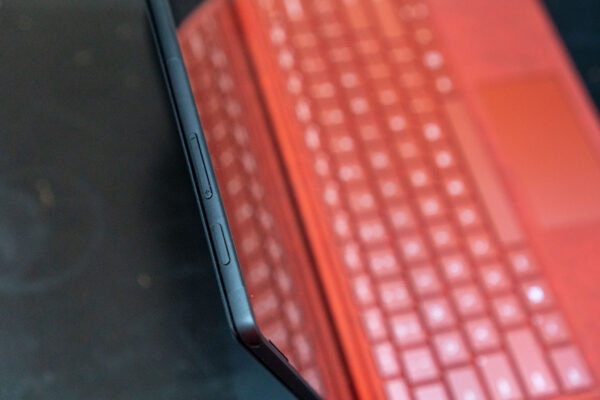
The Surface Pro Signature Type Cover is unchanged from before, but Microsoft has launched new colours with the Surface Pro 7: Poppy Red (as reviewed here) and Ice Blue. The keyboard is very good. Despite the small footprint, Microsoft has managed to make this keyboard feel spacious, and it’s very comfortable to type on. This is among the best of notebook keyboards, which is quite remarkable considering it’s on a detachable cover.
I also like that the keyboard has an entirely standard layout, without any keys in unexpected locations. They are also backlit so you can comfortably work in the dark.
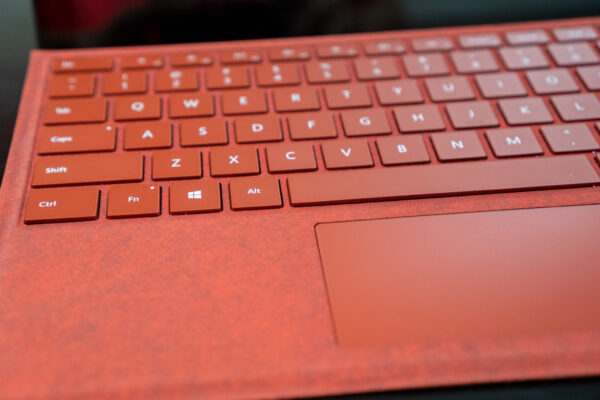
The Type Cover has a touchpad which is, not big, but perhaps can’t get much bigger given the size of the cover and without compromising on the keyboard. The glass surface feels great, but mult-touch gestures, which are supported with Windows Precision drivers, feel a little crammed.
While the typical convertible notebooks with a screen that folds behind the base tend to be unwieldy to hold, the Surface Pro 7 is still comfortable to hold with the Type Cover folded behind it. This is important if you want the best tablet experience, and don’t want to be burdened about detaching a keyboard.
The Surface Pen is also unchanged from before, though again, there are new colours, you guessed it, Poppy Red and Ice Blue, launched with the Surface Pro 7. Microsoft’s Surface Pen is, in my opinion, one of the most comfortable stylus ever, and most reliably mimicking the feel of writing with a pen on paper. The pen supports 4,096 levels of pressure sensitivity and has tilt support. There’s no storage for the pen, but it clips on magnetically to the side of the tablet.
Under the hood, the Surface Pro 7 now comes with Intel 10th generation Ice Lake-based processors, with configurations offered with i3-1005G1, i5-1035G4, and i7-1065G7. The i5 and i7 models have the new Intel Iris Plus Graphics, while the entry level processor uses UHD Graphics. Memory configurations of 4 GB, 8 GB, and 16 GB LPDDR4x are available, and for storage, there are options for 128 GB, 256 GB, 512 GB, or 1 TB. (Not every combination of configuration is available.)
My review unit is configured with an i7-1065G7 and 16 GB of RAM and 256 GB of storage. The new Ice Lake platform is proving to deliver great performance. The i7-1065G7 having Iris Plus Graphics with 64 execution units is quite formidable. These are the scores from PCMark 10 Extended:
- Overall: 3825
- Essentials: 9140
- Productivity: 9050
- Digital Content Creation: 3756
- Gaming: 2390
From Geekbench 5 (and 4 in parenthesis), the scores are:
- Single-Core: 1326 (5789)
- Multi-Core: 4770 (19353)
- Compute: 10369 (39579)
Battery life is good, though not as good as one might have expected from a tablet. I recently moved to using PCMark 10 Battery tests with the Modern Office workload, and the Surface Pro 7 ran for 10 hours 29 minutes with a benchmark score of 5157. Under the old PCMark 8 Home Conventional battery test, it ran for 4 hours 6 minutes, and achieved a 2531 score. You should get 10 hours of real world use with the Surface Pro 7.
For wireless connectivity, the Surface Pro 7 supports Wi-Fi 6 (802.11ax) and Bluetooth 5.0.
In the box, the Surface Pro 7 comes with a power adapter that uses the Surface Connect port. Surface Type Cover and Surface Pen are sold separately, although sometimes you may find bundle offers.
The Surface Pro 7 is an excellent tablet. It can transform into a notebook in a cinch, provided you get the Type Cover. However, it may not be the most comfortable notebook to use on your lap, or even on an airline seat tray table.
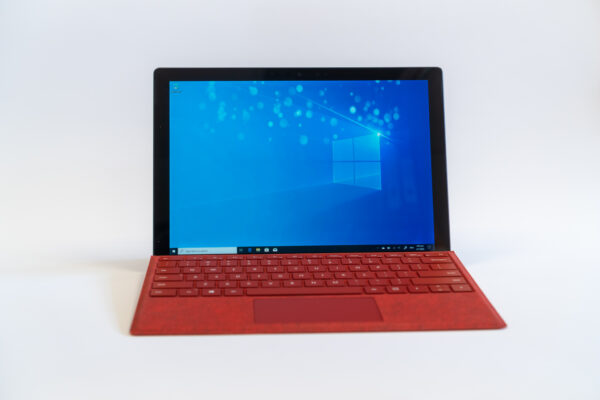
If the situations you need the Surface Pro 7 to work as notebook will always be at a desk, then it may work great for you. You’ll probably want to attach an external display, since the 12.3-inch display may be too small for serious desk work, and at that point, you may also want an external mouse and keyboard, since the Type Cover’s touchpad is rather small.
There’s not much changed from the Surface Pro 6, but the new USB Type-C port on the Surface Pro 7 could be important enough an upgrade for some people. Just for that alone, I can genuinely recommend the Surface Pro 7 for most users. If you don’t ever plan to plug in an eGPU, the lack of Thunderbolt 3 isn’t a showstopper. The upgrade to 10th generation Ice Lake-based Intel processors brings the Surface Pro 7 up-to-date with the competition.
It’s worth noting that an ARM-based Surface has come back in the form of the Surface Pro X which launched alongside this Surface Pro 7. I think, however, an ARM-based Surface is still something interesting, but it’s the regular Intel-based tablet that will work best for most people.
The Surface Pro 7, as configured in this review (i7-1065G7, 16 GB, 256 GB) retails at $2,188. The Surface Pro Signature Type Cover is S$249, although you can pick up a more basic Surface Pro Type Cover for S$199. The Surface Pen is S$148 (presently discounted to S$118.40. You’re looking at well over S$2,500 with these accessories included.
Conclusion
The Microsoft Surface Pro 7 finally gets USB Type-C with Power Delivery, making it now something easy to recommend to users who mainly need a tablet that’s ready to transform to a notebook in a cinch.
Pros:
- USB Type-C, finally
- Overall an excellent tablet
- Great performance from 10th generation Ice Lake Intel processors
- Excellent keyboard (separate purchase)
Cons:
- Not most convenient
- Type Cover and Pen not included
View Comment Policy